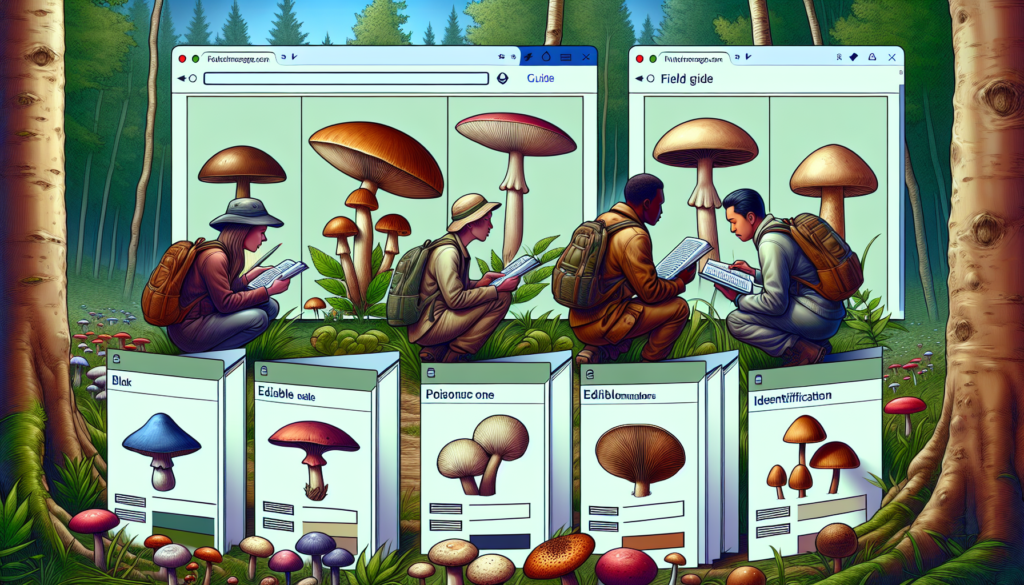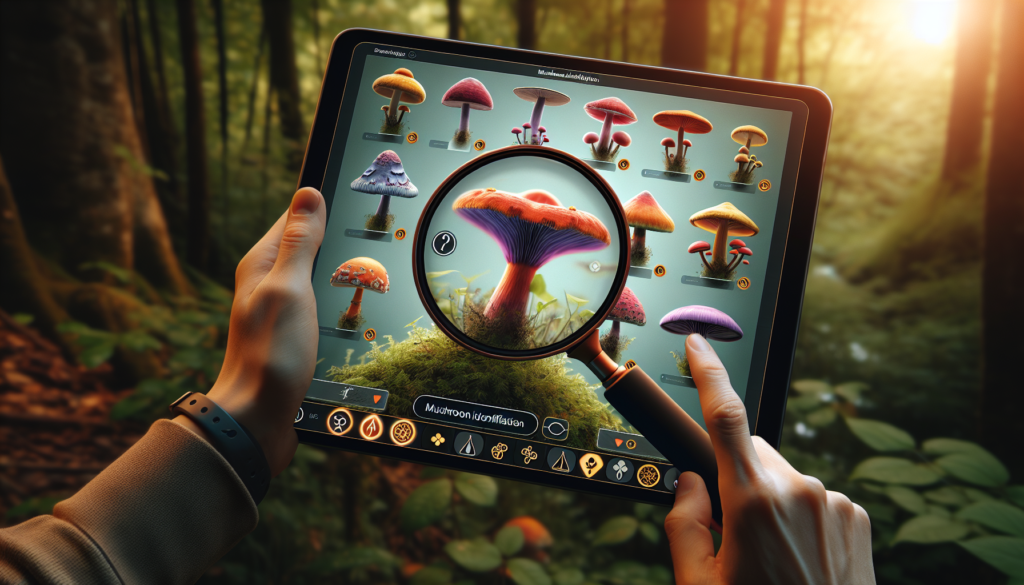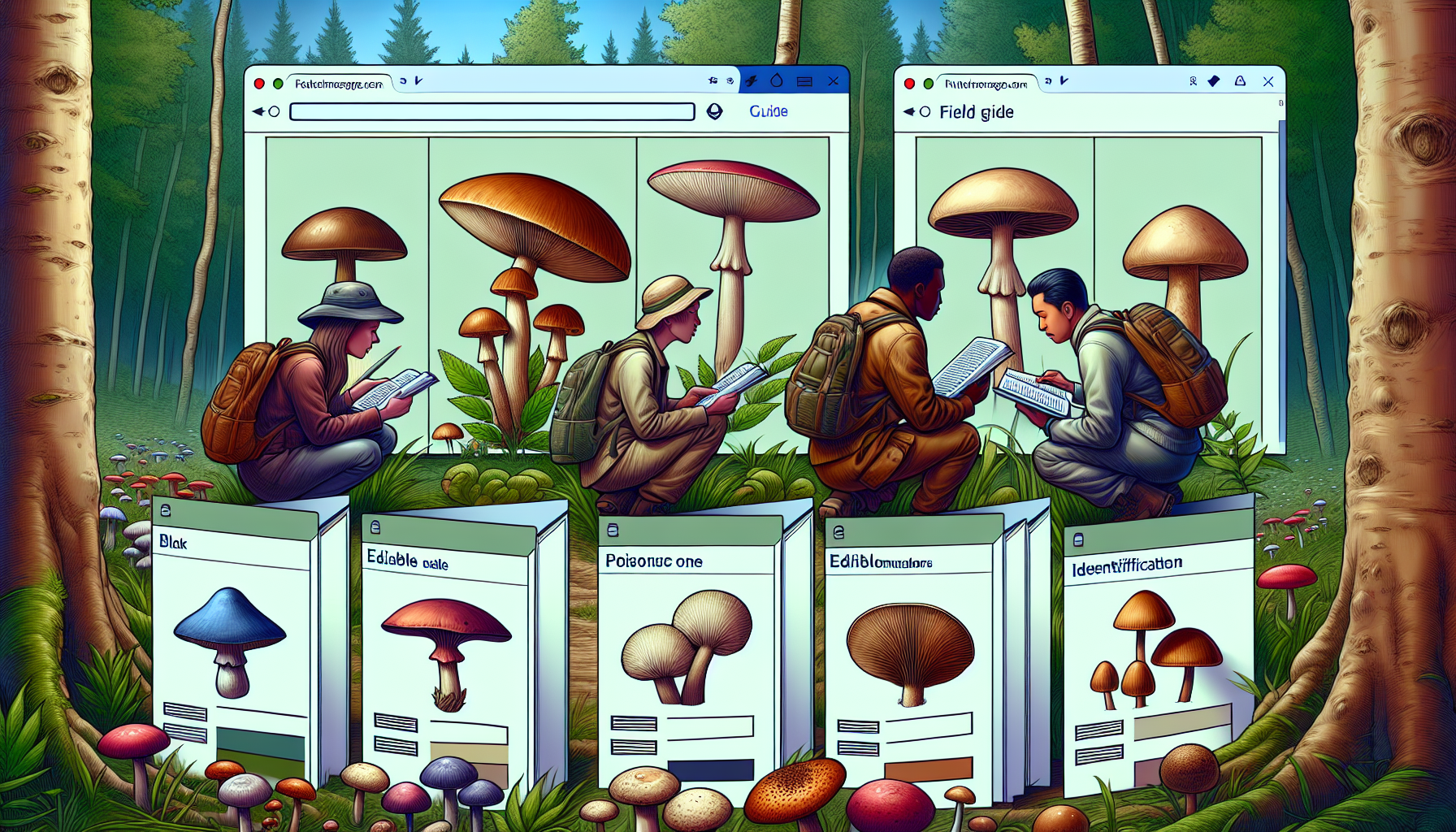Have you ever stumbled across a curious-looking mushroom during a hike or while wandering through your backyard? Whether you’re an amateur mycologist or simply intrigued by the diverse world of fungi, the quest for mushroom identification can be a challenging one. Luckily, in the age of the internet, there are numerous online resources available to assist you. From interactive identification keys to community forums, these resources provide a wealth of knowledge and expertise to help you unravel the mystery of those fascinating fungi you encounter. So, next time you come across an enigmatic mushroom, fear not! With online resources at your fingertips, the world of mushroom identification is just a click away. Yes, there are plenty of online resources available for mushroom identification. Whether you are a novice mushroom enthusiast or an experienced forager, these resources can help you identify and learn about the different types of mushrooms. In this article, we will explore the various types of online resources, including mushroom identification websites, online forums and communities, mobile applications, and educational resources. We will also discuss the use of social media platforms, offline resources, and the importance of safety and accuracy when identifying mushrooms. Additionally, we will address the challenges and limitations that may arise when using online resources for mushroom identification.

Mushroom Identification Websites
Mushroom identification websites are a valuable resource for anyone looking to identify mushrooms. These websites typically provide a comprehensive database of mushroom species along with detailed information, photographs, and identification keys. Here are a few popular mushroom identification websites that you can explore:
-
MushroomExpert.com: This website, created by Michael Kuo, is a fantastic resource for both beginners and experienced mushroom hunters. It features a wide range of mushroom species with detailed descriptions, high-quality photographs, and helpful identification tips. The website also includes information about mushroom taxonomy, ecology, and cooking.
-
iNaturalist.org: iNaturalist is a popular online community for nature enthusiasts and provides a platform for uploading and identifying observations, including mushrooms. Users can upload photographs of mushrooms and receive help from the community in identifying them. The website also offers a mushroom-specific project where users can contribute their observations and help create a comprehensive record of mushroom biodiversity.
-
MycoKeys: MycoKeys is an open-access journal dedicated to publishing articles related to mycology, including mushroom identification. The website offers a vast collection of peer-reviewed articles, some of which provide valuable information on mushroom identification, taxonomy, and ecology. While this resource may be more beneficial to advanced mushroom enthusiasts, it can still be a valuable source of information for beginners.
Online Forums and Communities
Online forums and communities provide an excellent platform for mushroom enthusiasts to connect, share knowledge, and seek help in identifying mushrooms. These platforms allow you to interact with experienced mushroom hunters, ask questions, and receive guidance. Here are a few well-known online forums and communities that you can join:
-
Mycological Society of America (MSA) Forum: The MSA Forum is a popular community for professional mycologists and mushroom enthusiasts alike. It offers a space to discuss various topics related to mycology, including mushroom identification. The forum is a great place to seek guidance from experts and engage in meaningful conversations with fellow mushroom enthusiasts.
-
Reddit’s r/mycology: Reddit is a bustling online platform with communities dedicated to nearly every topic, including mycology. The r/mycology subreddit is an active and friendly community where you can share photographs of mushrooms, seek identification help, and interact with fellow mushroom enthusiasts. It’s a great resource for both beginners and experienced mushroom hunters.
-
Shroomery Forum: The Shroomery Forum is a popular online forum specifically focused on psychedelic mushrooms, but it also offers valuable resources for identifying other types of mushrooms. The forum has a large user base and covers a wide range of topics related to mushroom cultivation, identification, and experiences. It’s a good place to seek help and learn from the experiences of others.
Mobile Applications
In today’s technological age, mobile applications have become an increasingly popular way to access information on the go. Several mushroom identification apps are available for both iOS and Android devices, making it convenient to identify mushrooms in the field. Here are a few notable mushroom identification apps:
-
iMushroom Guide: iMushroom Guide is a comprehensive app that offers a vast database of mushroom species, photographs, and identification information. The app allows users to search for mushrooms based on their characteristics, such as color, shape, and habitat. It also includes a handy glossary of mycological terms and a collection of recipes for cooking mushrooms.
-
Mushroom ID: Mushroom ID is another popular app that facilitates mushroom identification. It features a simple and user-friendly interface, making it easy to navigate through the app’s extensive database of mushroom species. The app provides detailed descriptions, photographs, and identification tips to help users identify mushrooms accurately.
-
Mushrooms – Identify and learn about mushrooms: This app is specifically designed for mushroom enthusiasts and offers comprehensive information on various mushroom species. It includes a mushroom recognition tool that uses artificial intelligence to identify mushrooms based on photographs. The app also provides educational content, such as quizzes, articles, and videos to enhance your knowledge about mushrooms.
Educational Resources
If you are looking to delve deeper into the world of mushrooms and expand your knowledge, there are several educational resources available online. These resources offer valuable information on mushroom identification, taxonomy, ecology, and more. Here are a few noteworthy educational resources:
-
National Audubon Society’s Mushroom Identification Guide: The National Audubon Society’s Mushroom Identification Guide is a comprehensive resource for mushroom enthusiasts. It covers a wide range of mushroom species, providing detailed descriptions, photographs, and key identification features. The guide also offers valuable information on mushroom ecology, including their role in ecosystems and their relationships with other organisms.
-
University of California’s Mycology Virtual Museum: The Mycology Virtual Museum is an online platform that offers a wealth of educational resources related to mushrooms and mycology. It features virtual exhibits showcasing various mushroom species, as well as interactive keys and quizzes for mushroom identification. The museum also provides access to a vast collection of scientific articles and research papers.
-
North American Mycological Association (NAMA): NAMA is an organization dedicated to promoting the study and enjoyment of mushrooms. Their website offers a range of educational resources, including articles, publications, and information on mushroom forays and workshops. NAMA also hosts an annual foray, where participants can join expert-led mushroom hunting expeditions and learn from experienced mycologists.

Social Media Platforms
Social media platforms have become an increasingly popular means of sharing and discovering information, including mushroom identification. Several platforms offer mushroom-related content and communities where you can engage with fellow mushroom enthusiasts. Here are a few social media platforms that you can explore:
-
Instagram Hashtags: Instagram is a visually-driven platform that attracts many nature photographers and mushroom enthusiasts. By searching for hashtags such as #mushroomsofinstagram or #mushroomidentification, you can find a plethora of photographs and information about different mushroom species. Instagram also allows you to follow accounts dedicated to mushrooms and nature, providing a continuous stream of mushroom-related content.
-
Facebook Groups: Facebook is another platform with dedicated groups and communities focused on mushrooms. These groups offer a space for mushroom enthusiasts to connect, share photographs, ask questions, and seek identification assistance. By joining these groups, you can engage in discussions, learn from experienced members, and expand your knowledge of mushrooms.
-
Pinterest Boards: Pinterest is a visual bookmarking platform that allows users to discover, save, and organize content. Many mushroom enthusiasts create Pinterest boards dedicated to mushrooms, where they curate photographs, articles, and resources related to mushroom identification. By searching for mushroom-related keywords on Pinterest, you can find a collection of visually appealing and informative content.
Offline Resources
While online resources are convenient and accessible, offline resources can also be valuable when it comes to mushroom identification. These resources include field guides, mycology courses and workshops, and local mushroom clubs. Here’s how they can contribute to your mushroom identification journey:
-
Field Guides: Field guides are books specifically designed to help identify plants, animals, and fungi in their natural habitat. Many excellent field guides are available for mushrooms, providing illustrations, detailed descriptions, and identification keys. Field guides are particularly useful when you are out in the field and do not have access to online resources or mobile applications.
-
Mycology Courses and Workshops: Many universities, botanical gardens, and other educational institutions offer mycology courses and workshops. These courses provide in-depth knowledge of mushrooms, including identification, taxonomy, ecology, and cooking. Attending a mycology course or workshop can give you hands-on experience and the opportunity to learn from experienced mycologists.
-
Local Mushroom Clubs: Local mushroom clubs are a great way to connect with fellow mushroom enthusiasts in your area. These clubs often organize forays and events where members can go on guided mushroom hunts and learn from experienced club members. Joining a local mushroom club can provide you with a community of like-minded individuals who can offer guidance and support in your mushroom identification journey.
Safety and Accuracy
When it comes to mushroom identification, safety and accuracy are of utmost importance. While online resources can be helpful, it is crucial to exercise caution and verify the information you find. Here are a few tips to ensure safety and accuracy when using online resources for mushroom identification:
-
Consulting Multiple Sources: It is always a good idea to consult multiple sources when identifying mushrooms. Cross-referencing information from different websites, books, and field guides can help ensure accuracy. If multiple sources agree on the identification of a mushroom, it is more likely to be correct.
-
Using Photos and Descriptions: When using online resources, pay close attention to the photographs and descriptions provided. Look for key identification features described in the text and compare them with the photographs. High-quality, well-lit photographs can be especially helpful for accurate identification.
-
Seeking Expert Advice: If you are unsure about the identification of a mushroom, it is best to seek expert advice. Online forums, local mushroom clubs, and mycological societies are great places to connect with experienced mycologists who can help verify your identification. Experts can provide valuable insights and help you avoid potentially toxic or dangerous mushrooms.
Challenges and Limitations
While online resources for mushroom identification are incredibly useful, they do come with their own set of challenges and limitations. Understanding these challenges can help you navigate the identification process more effectively. Here are a few common challenges and limitations that you may encounter:
-
Fruiting Body Identification: Online resources often rely on photographs and descriptions of the mushroom’s fruiting body (the visible part of the mushroom) for identification. However, some mushrooms may have similar-looking fruiting bodies, making accurate identification difficult. It is important to remember that other parts of the mushroom, such as the spore color and microscopic features, may also be necessary for accurate identification.
-
Region-Specific Species: Mushroom species vary geographically, and some species may be specific to certain regions or habitats. Online resources may not always provide information on region-specific species, resulting in inaccurate identification. It is essential to consider your local ecosystem and consult region-specific resources if available.
-
Seasonality and Habitat: Mushroom species have specific seasonal and habitat preferences. Online resources may not always provide information on when and where certain mushrooms are most likely to be found. Understanding the seasonality and habitat preferences of mushrooms in your region can greatly aid in accurate identification.
Conclusion
Online resources have revolutionized the way we identify and learn about mushrooms. Mushroom identification websites, online forums and communities, mobile applications, educational resources, and social media platforms offer a wealth of information and opportunities to connect with fellow mushroom enthusiasts. Offline resources such as field guides, mycology courses and workshops, and local mushroom clubs also play a crucial role in mushroom identification. However, it is important to approach these resources with caution, ensuring safety and accuracy by consulting multiple sources, using photos and descriptions, and seeking expert advice when necessary. While challenges and limitations exist, online and offline resources, when used in conjunction with each other, can greatly enhance your mushroom identification journey. So, go forth with confidence, explore the vast world of mushrooms, and continue to learn and marvel at these fascinating organisms. Happy mushroom hunting!


No Responses